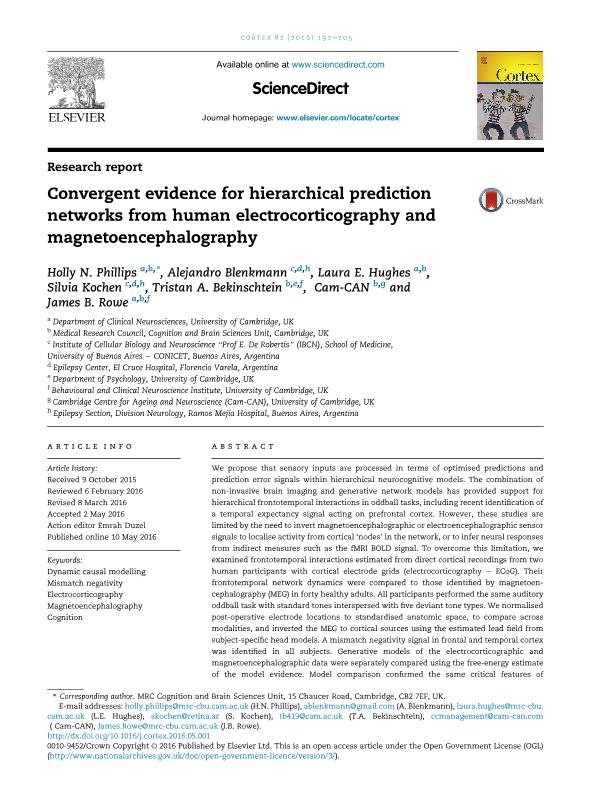Mostrar el registro sencillo del ítem
dc.contributor.author
Phillips, Holly N.

dc.contributor.author
Blenkmann, Alejandro Omar

dc.contributor.author
Hughes, Laura E.

dc.contributor.author
Kochen, Sara Silvia

dc.contributor.author
Bekinschtein, Tristán Andrés

dc.contributor.author
Cambridge Centre for Ageing and Neuroscience
dc.contributor.author
Rowe, James B.

dc.date.available
2018-06-11T14:51:05Z
dc.date.issued
2016-09
dc.identifier.citation
Phillips, Holly N.; Blenkmann, Alejandro Omar; Hughes, Laura E.; Kochen, Sara Silvia; Bekinschtein, Tristán Andrés; et al.; Convergent evidence for hierarchical prediction networks from human electrocorticography and magnetoencephalography; Elsevier Masson; Cortex; 82; 9-2016; 192-205
dc.identifier.issn
0010-9452
dc.identifier.uri
http://hdl.handle.net/11336/48054
dc.description.abstract
We propose that sensory inputs are processed in terms of optimised predictions and prediction error signals within hierarchical neurocognitive models. The combination of non-invasive brain imaging and generative network models has provided support for hierarchical frontotemporal interactions in oddball tasks, including recent identification of a temporal expectancy signal acting on prefrontal cortex. However, these studies are limited by the need to invert magnetoencephalographic or electroencephalographic sensor signals to localise activity from cortical ‘nodes’ in the network, or to infer neural responses from indirect measures such as the fMRI BOLD signal. To overcome this limitation, we examined frontotemporal interactions estimated from direct cortical recordings from two human participants with cortical electrode grids (electrocorticography – ECoG). Their frontotemporal network dynamics were compared to those identified by magnetoencephalography (MEG) in forty healthy adults. All participants performed the same auditory oddball task with standard tones interspersed with five deviant tone types. We normalised post-operative electrode locations to standardised anatomic space, to compare across modalities, and inverted the MEG to cortical sources using the estimated lead field from subject-specific head models. A mismatch negativity signal in frontal and temporal cortex was identified in all subjects. Generative models of the electrocorticographic and magnetoencephalographic data were separately compared using the free-energy estimate of the model evidence. Model comparison confirmed the same critical features of hierarchical frontotemporal networks in each patient as in the group-wise MEG analysis. These features included bilateral, feedforward and feedback frontotemporal modulated connectivity, in addition to an asymmetric expectancy driving input on left frontal cortex. The invasive ECoG provides an important step in construct validation of the use of neural generative models of MEG, which in turn enables generalisation to larger populations. Together, they give convergent evidence for the hierarchical interactions in frontotemporal networks for expectation and processing of sensory inputs.
dc.format
application/pdf
dc.language.iso
eng
dc.publisher
Elsevier Masson

dc.rights
info:eu-repo/semantics/openAccess
dc.rights.uri
https://creativecommons.org/licenses/by-nc-sa/2.5/ar/
dc.subject
Dynamic Causal Modelling
dc.subject
Mismatch Negativity
dc.subject
Electrocorticography
dc.subject
Cognition
dc.subject.classification
Salud Ocupacional

dc.subject.classification
Ciencias de la Salud

dc.subject.classification
CIENCIAS MÉDICAS Y DE LA SALUD

dc.title
Convergent evidence for hierarchical prediction networks from human electrocorticography and magnetoencephalography
dc.type
info:eu-repo/semantics/article
dc.type
info:ar-repo/semantics/artículo
dc.type
info:eu-repo/semantics/publishedVersion
dc.date.updated
2018-06-08T14:27:09Z
dc.journal.volume
82
dc.journal.pagination
192-205
dc.journal.pais
Argentina

dc.journal.ciudad
Paris
dc.description.fil
Fil: Phillips, Holly N.. Cognition and Brain Sciences Unit; Reino Unido. University of Cambridge; Reino Unido
dc.description.fil
Fil: Blenkmann, Alejandro Omar. Consejo Nacional de Investigaciones Científicas y Técnicas. Oficina de Coordinación Administrativa Houssay. Instituto de Biología Celular y Neurociencia ; Argentina. Provincia de Buenos Aires. Ministerio de Salud. Hospital Alta Complejidad en Red El Cruce Dr. Néstor Carlos Kirchner Samic; Argentina. Gobierno de la Ciudad de Buenos Aires. Hospital General de Agudos ; Argentina
dc.description.fil
Fil: Hughes, Laura E.. Cognition and Brain Sciences Unit; Reino Unido. University of Cambridge; Reino Unido
dc.description.fil
Fil: Kochen, Sara Silvia. Gobierno de la Ciudad de Buenos Aires. Hospital General de Agudos ; Argentina. Provincia de Buenos Aires. Ministerio de Salud. Hospital Alta Complejidad en Red El Cruce Dr. Néstor Carlos Kirchner Samic; Argentina. Consejo Nacional de Investigaciones Científicas y Técnicas. Oficina de Coordinación Administrativa Houssay. Instituto de Biología Celular y Neurociencia ; Argentina
dc.description.fil
Fil: Bekinschtein, Tristán Andrés. University of Cambridge; Reino Unido. Cognition and Brain Sciences Unit; Reino Unido
dc.description.fil
Fil: Cambridge Centre for Ageing and Neuroscience. No especifica;
dc.description.fil
Fil: Rowe, James B.. Cognition and Brain Sciences Unit; Reino Unido. University of Cambridge; Reino Unido
dc.journal.title
Cortex

dc.relation.alternativeid
info:eu-repo/semantics/altIdentifier/doi/https://dx.doi.org/10.1016%2Fj.cortex.2016.05.001
dc.relation.alternativeid
info:eu-repo/semantics/altIdentifier/url/https://www.sciencedirect.com/science/article/pii/S0010945216301058
dc.relation.alternativeid
info:eu-repo/semantics/altIdentifier/url/https://www.ncbi.nlm.nih.gov/pmc/articles/PMC4981429/
Archivos asociados
